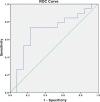Improving the Preoperative Diagnostic Accuracy of Acute Appendicitis. Can Fecal Calprotectin Be Helpful?
- PMID: 28033410
- PMCID: PMC5199045
- DOI: 10.1371/journal.pone.0168769
Improving the Preoperative Diagnostic Accuracy of Acute Appendicitis. Can Fecal Calprotectin Be Helpful?
Abstract
Background: Is the patient really suffering from acute appendicitis? Right lower quadrant pain is the most common sign of acute appendicitis. However, many other bowels pathologies might mimic acute appendicitis. Due to fear of the consequences of delayed or missed diagnosis, the indication for emergency appendectomy is liberally made. This has been shown to be associated with high rates of negative appendectomy with risk of potentially serious or lethal complications. Thus there is need for a better preoperative screening of patients with suspected appendicitis.
Methods: This prospective single center single-blinded pilot study was conducted in the Department of surgery at the HELIOS Universitätsklinikum Wuppertal, Germany. Calprotectin was measured in pre-therapeutic stool samples of patients presenting in the emergency department with pain to the right lower quadrant. Fecal calprotectin (FC) values were analyzed using commercially available ELISA kits. Cut-off values for FC were studied using the receiver-operator characteristic (ROC) curve. The Area under the curve (AUC) was reported for each ROC curve.
Results: The mean FC value was 51.4 ± 118.8 μg/g in patients with AA, 320.9 ± 416.6 μg/g in patients with infectious enteritis and 24.8 ± 27.4 μg/g in the control group. ROC curve showed a close to 80% specificity and sensitivity of FC for AA at a cut-off value of 51 μg/g, AUC = 0.7. The sensitivity of FC at this cut-off value is zero for enteritis with a specificity of 35%.
Conclusion: Fecal calprotectin could be helpful in screening patients with pain to the right lower quadrant for the presence of acute appendicitis or infectious enteritis with the aim of facilitating clinical decision-making and reducing the rate of negative appendectomy.
Conflict of interest statement
The authors have declared that no competing interests exist.
Figures






References
-
- Wagner JM, McKinney WP, Carpenter JL: Does this patient have appendicitis? JAMA 1996, 276(19):1589–1594. - PubMed
MeSH terms
Substances
LinkOut - more resources
Full Text Sources
Other Literature Sources
Medical

